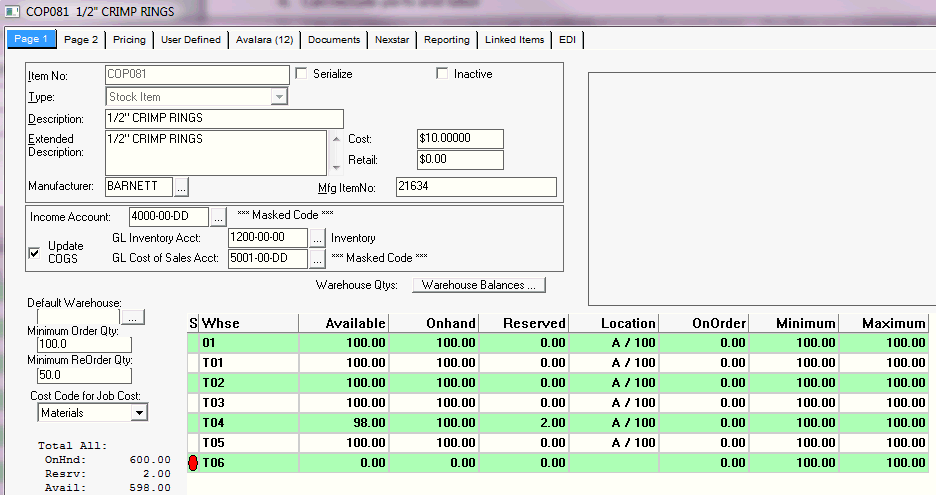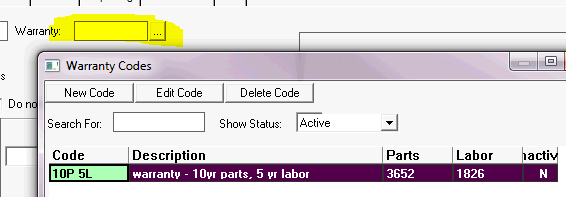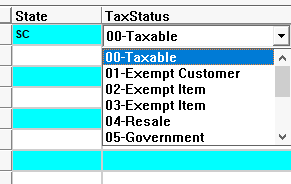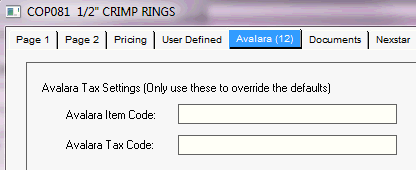
Stock items allow you to track the quantity on-hand, quantity reserved, and quantity on purchase orders. When you receive a stock item, your inventory general ledger account is increased by the cost of the item and the cost is record in the item cost table to allow tracking for your inventory costing method, LIFO, FIFO, or Average. ServMan also requires stock items be in inventory - hand an on-hand quantity greater than zero - when invoices are posted. After all, you cannot sell something you do not technically have.
From the Item SmartView, right click and select Add




Unit Settings (UOM) - You can set units of measure for how an item is Purchased, Stocked and Sold. The Unit of Measure (UOM) can be used alone or in conjunction with Conversion codes. Common Unit of Measure codes are Each, Hour, Day or Case -define how items are purchased or sold in ServMan
Conversion Codes – Used when the sales UOM is different than the purchase UOM the purchasing/receiving UOM will be displayed on purchase orders and vendor bills, while the stocking UOM is reference only. The sales UOM will be displayed on orders, invoices and quotes. Click HERE for more information about Conversion Codes.

Leaving this field blank or entering a Y will allow this item to print on quotes, orders and invoices.
Setting this field to N may be useful if you have items that you add to orders and invoices for costing purposes, but may not want your customer to see on their paperwork.
One other common value is D. If this field is set to D then only the description (not the item number or price) will display on the quote, order or invoice.
NOTE: the value in this field may be overridden on the quote, order or invoice.

Tax Exempt - Check this box if the item is Tax Exempt
NOTE: As of Release 2017 A.27 - This check box has been replaced by a drop down list with 3 options:
Tax Status based on client
Tax Exempt
Tax Status based on state
When you select "Tax status based on state", a new screen will appear that will let you determine the tax status by state

In the State column, you should enter the Post Office's two character state abbreviation for the client's location account used on the work order
In the TaxStatus column, the drop down list will let you set the tax status for this item in the appropriate state. You may enter as many state codes as you wish.

If your item does not need to have its tax status determined by state, then you do not have to change anything.
If you wish to modify your item's tax status's en masse, our Support department can help you perform the following tasks:
Set the TAX_EXEMPT fields on the appropriate items to "S"
Add a record in the ITEMTAXSTATUS table with the appropriate setting for each item for each state (where the state affects the tax status of the item)
Download to Mobile - Check this box for the item to be downloaded to mobile devises configured to receive it
Is a Loaner - Click HERE for more information
Prompt for Label Quantity - If you are using the Wireless Warehouse module, the system will print labels upon receipt of the items
Is Consignment - Click HERE for more information
Exempt from Commissions - If using Commission reporting, the item can be exempt
Spiff Amount - Amount given to the LEAD tech - recorded in the Tech Performance Report and in our integrated payroll
Piece Rate - Amount given to the LEAD tech - used in our integrated payroll
ComCode - code applied to an item when it is used on quotes, orders and invoices for the purpose of commission reporting to the integrated payroll system
Default Vndr -Used by the AutoPurchasing Module - if set, purchases will default to this vendor
Default Vndr PartNo - If set, will populate purchase orders created for the default vendor
Lead Time - Number of days it usually takes to receive this item from a vendor
PO Description Option - Used when creating a PO directly from an order - Default means to use the description from the item. Select Always use order detail description to use the description the tech entered on the order detail. (Usually used for Misc or specialty non-stock items)

Skill Sets Required - If this item requires a special skill set to install, enter that here. Aids in scheduling orders with this item to qualified techs
Group Codes - Used when downloading items to mobile. Click HERE for further information.
Contract Activity - Not used on Stock items - Click HERE for further information.
Loyalty Type - If this item will give Loyalty Points to a client when purchased, select the proper type from the dropdown. - Click HERE for further information.

Enter the Avalara's Item and Tax codes only if you use Avalara to calculate your taxes. Click HERE for further information.
"Stock but don't value" items act the same as regular stock items, allowing you to track the quantity on-hand, quantity reserved, and quantity on purchase orders. However, when you receive this type of stock item but don't value it, your inventory general ledger account is not affected. This is accomplished simply by creating the item as a type of "STOCK" and then unchecking the update to "COGs" flag, both of which are located on the first page of the item setup screen.